How to Reheat Pad Thai
To reheat pad thai effectively, you've got several reliable methods at your disposal. For microwave reheating, place your noodles in a microwave-safe dish, add a tablespoon of water, and cover with a damp paper towel before heating for 30-second intervals. If you prefer using the stovetop, warm the dish in a skillet over medium-high heat for 3-4 minutes, stirring constantly and adding a splash of water or oil to prevent sticking. For best results, store your pad thai in an airtight container in the fridge for up to three days, keeping noodles and toppings separate to maintain ideal texture. These basic steps will get you started, but there's much more to perfecting the reheating process.
This post may contain affiliate links. If you make a purchase through these links, I may earn a commission at no additional cost to you. Additionally, portions of this post may be generated using artificial intelligence (AI) technology. While we strive for accuracy, please be aware that AI-generated content may not always be perfect and should be fact-checked when necessary.
The Spatula Scoops
- Microwave: Place in a covered dish with a tablespoon of water, heat for 30 seconds, stir, and let rest for one minute.
- Stovetop: Use medium-high heat in a skillet, add oil or water, and stir constantly for 3-4 minutes until heated through.
- Air fryer: Heat at 370°F in a covered dish with water for 5-7 minutes, stirring halfway through.
- Add moisture during reheating using water, oil, or damp paper towels to prevent noodles from drying out.
- Heat until internal temperature reaches 165°F, stirring periodically to ensure even warming and prevent overcooking.
What Makes Pad Thai Special
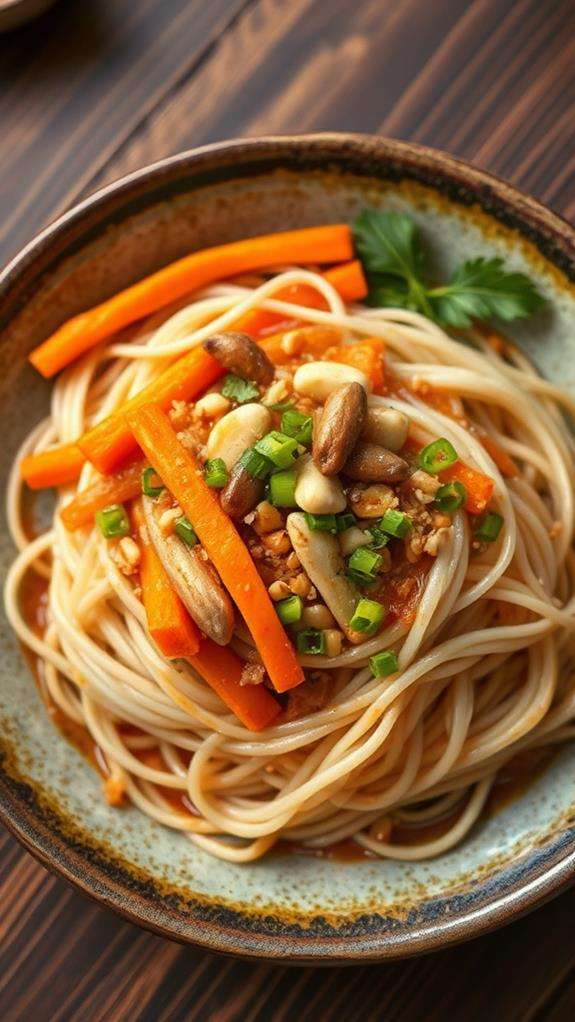
While many Thai dishes are beloved worldwide, Pad Thai stands out as Thailand's most celebrated culinary masterpiece. You'll discover a unique flavor profile that masterfully combines sweet, salty, sour, and spicy elements, creating a harmonious balance that's become the hallmark of this iconic dish.
At the heart of Pad Thai's appeal is its versatile tamarind-based sauce, which coats perfectly cooked rice noodles and your choice of protein, whether it's succulent shrimp, tender chicken, or silky tofu. The incorporation of fresh ingredients elevates your culinary experience, as crisp bean sprouts and crushed peanuts add delightful texture contrasts that make each bite interesting and satisfying.
What you'll appreciate most about Pad Thai is its adaptability to various dietary preferences. Whether you're a vegetarian or seafood lover, you can customize this dish to suit your tastes while maintaining its authentic character. The careful balance of ingredients creates a complete meal that's both filling and flavorful, making it easy to understand why this dish has captured the hearts of food enthusiasts across the globe.
Best Storage Methods
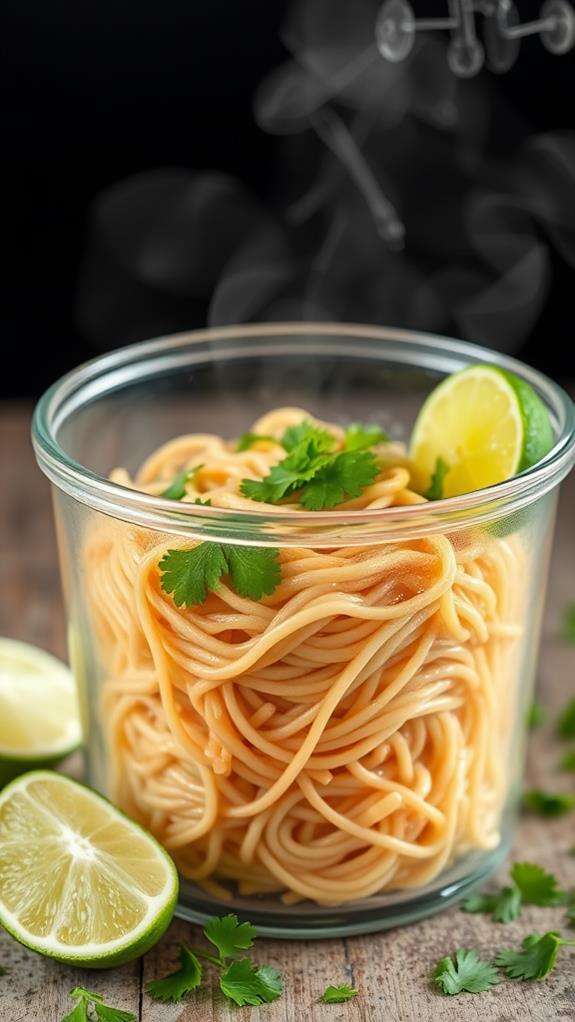
The key to maintaining Pad Thai's delightful texture and flavor lies in proper storage techniques. When you're dealing with leftovers, you'll want to implement proper storage methods within two hours of cooking to guarantee food safety and maximize freshness.
| Storage Type | Duration | Best Practices |
|---|---|---|
| Refrigeration | 3 days | Use airtight container, separate components |
| Freezer | 3 months | Double-wrap, remove air |
| Room Temp | 2 hours max | Transfer to fridge quickly |
To refrigerate leftovers properly, transfer your Pad Thai to an airtight container, but first, consider separating the noodles from the sauce and proteins. This separation prevents the noodles from becoming soggy during storage. If you're planning to freeze Pad Thai for longer storage, ascertain you're using freezer-safe containers or heavy-duty freezer bags with as much air removed as possible. Don't forget to label your containers with the storage date – this simple step helps you track freshness and maintain food safety standards. Whether you choose to refrigerate or freeze Pad Thai, proper storage will help maintain its authentic taste and texture for your next meal.
Microwave Reheating Steps
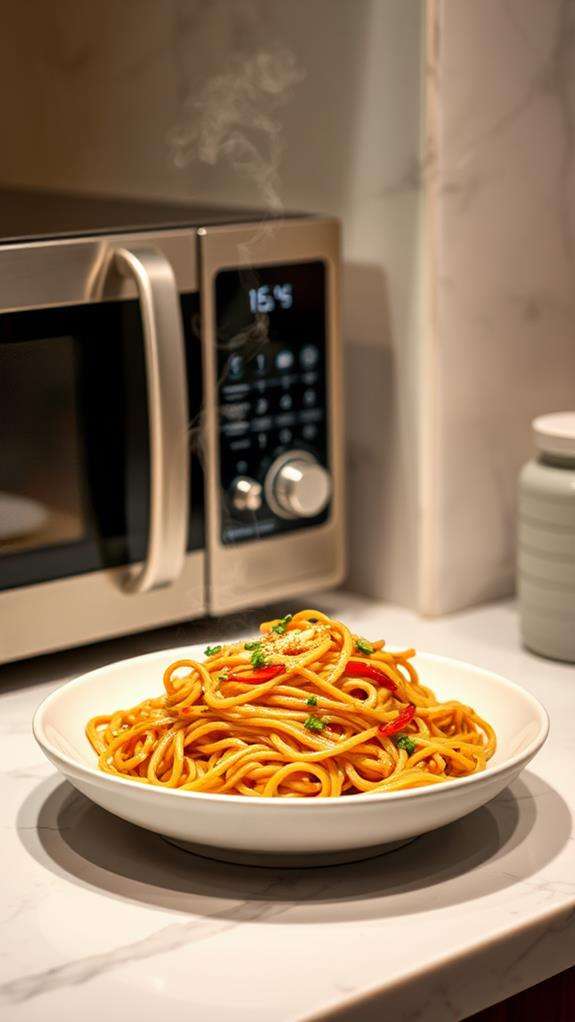
Now that you've properly stored your Pad Thai, reheating it in the microwave offers a quick and convenient method to enjoy your leftovers. Start by selecting an appropriate microwave-safe dish that gives your noodles enough space to spread out evenly, as overcrowding can lead to uneven heating.
Add a tablespoon of water to create moisture, then cover your dish with a damp paper towel. This step is essential as it creates steam during the reheating process, preventing your noodles from becoming dry and brittle. Set your microwave to high power and heat the Pad Thai for 30 seconds initially. After this first interval, stir the noodles thoroughly to distribute the heat evenly.
If you're planning to reheat for longer periods, reduce the power to 50% to maintain the dish's texture and prevent the noodles from becoming sticky. Continue heating in short intervals, checking the temperature until it reaches 165°F throughout. Once you've achieved the desired temperature, let your Pad Thai rest for one minute before serving to guarantee the heat distributes evenly through all ingredients.
Stovetop Reheating Technique
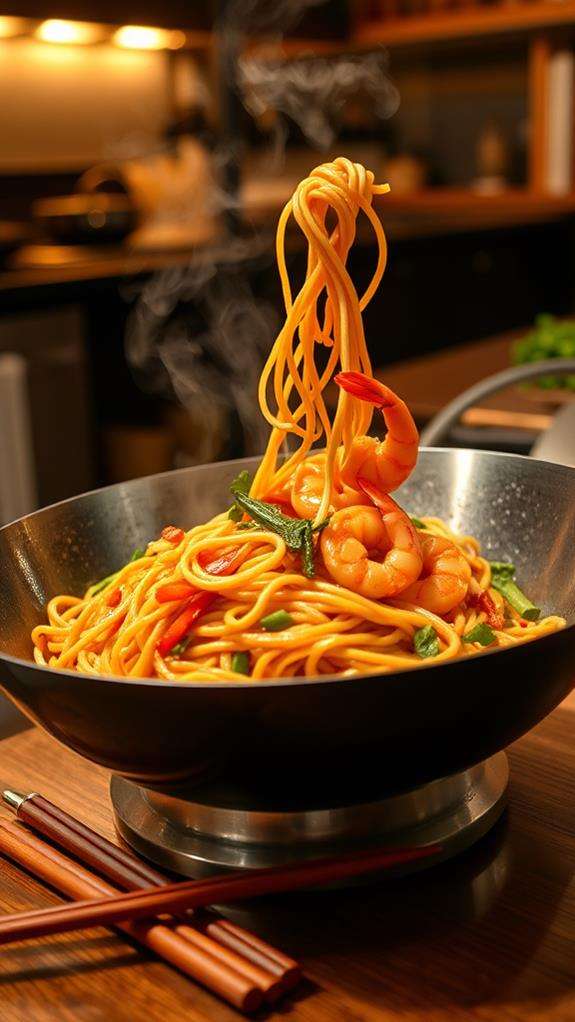
Reheating Pad Thai on the stovetop stands out as one of the most effective methods for restoring its original taste and texture. This stovetop method requires a skillet or wok set over medium-high heat, which helps distribute heat evenly throughout your leftover noodles.
To revive Pad Thai properly, you'll need to add a small amount of moisture to the pan. You can use either sesame oil or water, which will prevent the noodles from sticking and help restore their original consistency. As you heat the noodles, keep them moving constantly in the pan for about 3-4 minutes to guarantee even heating and prevent any burning.
Watch the sauce carefully as you're reheating, as it can thicken quickly or burn if left unattended. If you're working with a portion that includes proteins or vegetables, it's best to add these ingredients toward the end of the reheating process. This timing guarantees that your proteins won't become overcooked and your vegetables will maintain their crisp texture, resulting in a dish that's as close as possible to its fresh-made quality.
Air Fryer Method
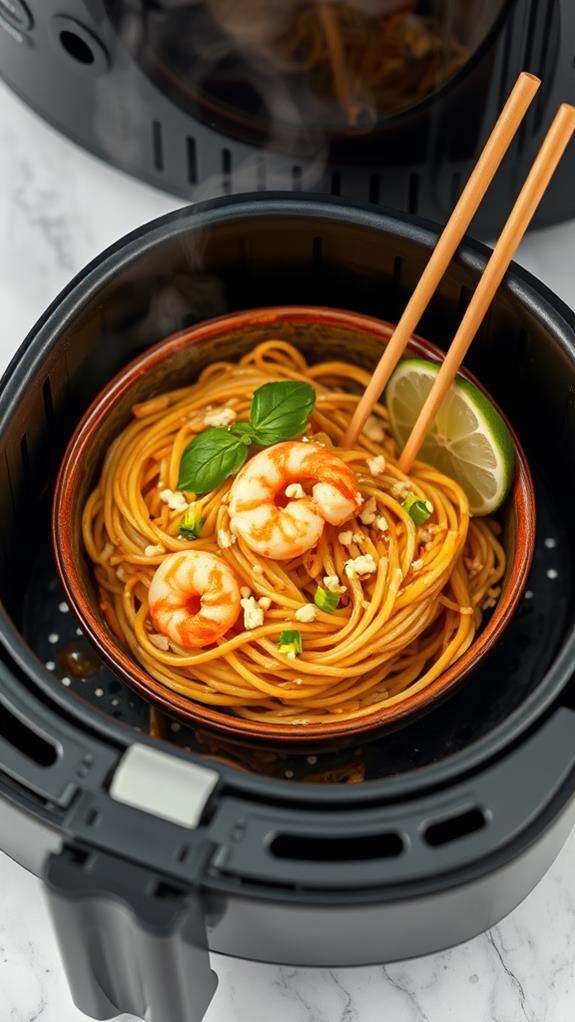
To achieve perfectly reheated Pad Thai in your air fryer, start by preheating it to 370°F (188°C) and placing your noodles in a covered, air fryer-safe dish with a tablespoon of water. Your noodles will need 5-7 minutes to heat thoroughly, but you'll want to stir them halfway through to prevent sticking and guarantee even warming. For the best results, double-check that your Pad Thai has reached 165°F (74°C) before serving, and keep the dish covered with foil to maintain the ideal moisture balance throughout the reheating process.
Optimal Temperature Settings
Setting your air fryer to the right temperature is vital for perfectly reheated Pad Thai. When considering ideal temperature settings, you'll want to preheat your air fryer to 400°F (200°C), which provides the perfect balance between thorough heating and maintaining the dish's texture. This temperature guarantees your noodles won't dry out while allowing the ingredients to warm evenly.
For the best reheating methods, follow these important temperature-related steps:
- Maintain a consistent 400°F throughout the entire reheating process, as fluctuating temperatures can lead to uneven results.
- If you're using an oven-safe dish or foil bowl, make sure it's properly centered in the air fryer basket for even heat distribution.
- Consider reducing the temperature to 375°F if you notice the edges browning too quickly, especially when working with smaller portions.
Adding a bit of moisture before reheating helps prevent the noodles from becoming tough at high temperatures. You'll know you've achieved the ideal temperature settings when the steam begins to rise from your Pad Thai after about 3-4 minutes of reheating, indicating that the moisture is properly circulating through the dish.
Prevent Noodle Drying
While temperature control plays a key role in reheating Pad Thai, keeping your noodles moist in the air fryer requires specific techniques. To prevent drying and guarantee even cooking, you'll need to create a protective environment that maintains moisture while allowing proper heat circulation.
| Step | Purpose | Duration | Key Tip |
|---|---|---|---|
| Foil Wrap | Moisture retention | Prep time: 2 min | Create loose wrap |
| Water Addition | Steam generation | Add 1 tbsp | Sprinkle evenly |
| Heat Distribution | Even cooking | 5-7 minutes | Check at halfway |
| Rest Period | Texture setting | 1 minute | Keep wrapped |
When you reheat your Pad Thai, start by creating a foil bowl or wrapping the dish loosely in foil, leaving some space at the top for steam circulation. You'll want to add a tablespoon of water before sealing the foil, as this creates steam that prevents the noodles from becoming tough or dry. During the reheating process, pause halfway through to stir the noodles, guaranteeing even heat distribution throughout the dish. This method maintains the authentic texture and prevents any sections from becoming overcooked or dried out.
Timing and Stirring Tips
In accordance with ideal air fryer reheating, mastering the timing and stirring sequence makes all the difference in achieving perfectly warmed Pad Thai. When reheating Pad Thai in your air fryer, you'll want to follow a precise timeline to guarantee your stir-fried rice noodles maintain their perfect texture and moisture content.
For best results, follow these essential timing guidelines:
- Begin by preheating your air fryer to 370°F (188°C), which typically takes 2-3 minutes
- Set your total cooking time to 8-10 minutes, marking the halfway point for stirring
- Remove your dish promptly when the noodles reach desired temperature to prevent drying
You'll need to stir your Pad Thai at the 4-5 minute mark, which helps distribute heat evenly throughout the dish. Don't forget to add that vital tablespoon of water before starting the reheating process, as it creates steam that keeps your noodles from becoming dry or brittle. Keep a close eye on your dish during the final minutes, as cooking times may vary slightly depending on your portion size and air fryer model.
Sauce Consistency Tips
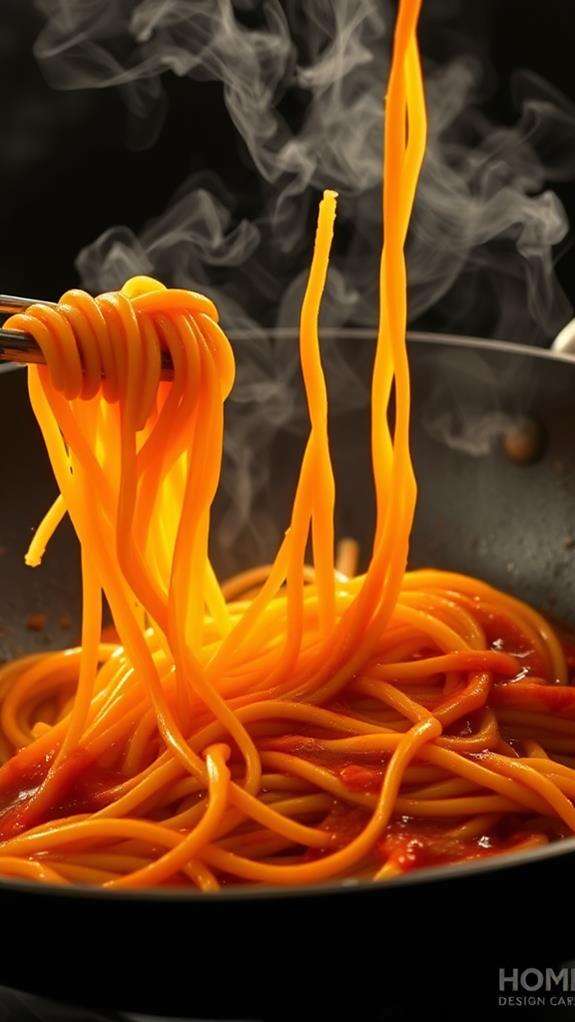
Managing your Pad Thai's sauce consistency can make or break your reheated leftovers. When you're ready to reheat your dish, you'll notice that the sauce has likely thickened during its time in the refrigerator, which can greatly impact the overall quality of your meal.
To maintain the perfect sauce consistency while reheating your Pad Thai leftovers, you'll want to add one to two tablespoons of water to prevent the sauce from becoming too thick. As you're reheating the dish, carefully observe how the sauce responds to the added moisture. You don't want it to become too runny, but rather achieve that ideal balance that makes Pad Thai so enjoyable.
For best results, you'll need to monitor the sauce throughout the reheating process. If you notice it's still too thick after adding the initial water, you can gradually incorporate small amounts until you reach the desired consistency. Remember, it's easier to add more water than to correct an oversaturated sauce. By maintaining proper sauce consistency, you'll make sure your leftover Pad Thai remains as flavorful and satisfying as when it was first prepared.
Adding Moisture While Reheating
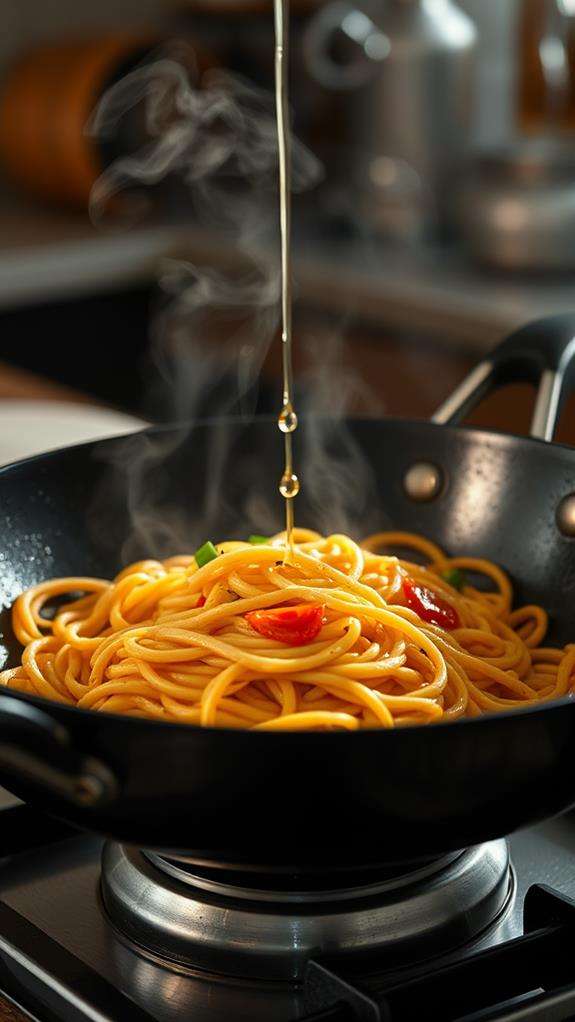
Proper moisture control goes hand in hand with sauce consistency when reheating Pad Thai. When you're ready to reheat leftover Pad Thai, you'll need to add moisture strategically to prevent the noodle dish from becoming dry and unpalatable. Adding a tablespoon of water before you start reheating helps rehydrate the rice noodles while maintaining their original texture.
To effectively manage moisture while reheating, follow these key steps:
- Place a damp paper towel over your Pad Thai when using the microwave, creating a steam environment that locks in moisture
- Add small amounts of water or oil incrementally during the reheating process, checking the noodle consistency between intervals
- Monitor the texture carefully, adding more liquid only when needed to prevent oversaturation
You'll want to pay attention to how your noodles respond as you reheat them. If they're still appearing dry after initial moisture addition, incorporate another small splash of water or oil. The goal is to achieve that perfect balance where your noodles are properly hydrated but not soggy, maintaining the authentic taste and texture of freshly made Pad Thai.
Preserving Original Flavors and Textures
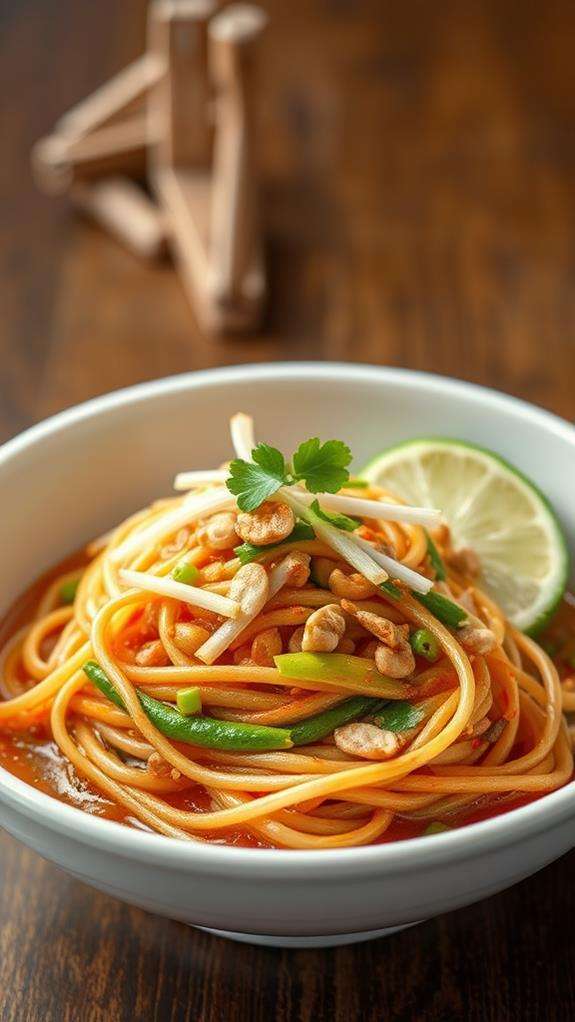
When you're reheating Pad Thai, using steam is your best ally for maintaining the dish's original flavors, as it helps lock in the aromatic components that make this Thai favorite so distinctive. You'll want to keep the temperature moderate, around medium heat, which allows the noodles to warm gradually while preserving their signature springy texture. By covering your Pad Thai during reheating, whether you're using a microwave with a damp paper towel or a stovetop with a lid, you'll create a moisture-rich environment that prevents the ingredients from drying out and helps restore the dish to its original glory.
Steam Locks In Flavor
Steaming effectively locks in the authentic flavors of Pad Thai while preserving its delicate textures during reheating. When you create steam by covering your dish with a damp paper towel, you're guaranteeing that moisture penetrates the ingredients evenly, preventing the rice noodles from becoming dry or rubbery. This controlled environment helps maintain the dish's signature taste profile while gently warming all components.
To achieve ideal results when steaming your Pad Thai, follow these essential steps:
- Add a small amount of water to create sufficient steam, which will help rehydrate the sauce and maintain its consistency
- Cover the dish properly to trap the moisture, guaranteeing even heat distribution throughout the ingredients
- Monitor the temperature carefully to prevent overcooking delicate components like shrimp and vegetables
The steam's gentle nature works to your advantage by preserving the integrity of each ingredient while simultaneously redistributing the flavors throughout the dish. You'll notice that when you use this method, the sauce remains well-incorporated, and the vegetables retain their crisp texture. This approach guarantees your reheated Pad Thai tastes as close to fresh as possible, maintaining both its authentic flavor profile and appealing texture.
Optimal Temperature For Texture
Temperature control serves as the key factor in preserving your Pad Thai's original texture and flavors during reheating. To properly reheat leftover Pad Thai, you'll want to aim for an internal temperature of 165°F (74°C), which guarantees food safety while maintaining the dish's integrity.
When using the stovetop, keep the heat at low to medium settings, as this prevents the rice noodles from becoming rubbery or mushy. You'll find that adding a tablespoon of moisture, either water or oil, helps maintain the ideal temperature while preventing the noodles from drying out. Stir the dish every few minutes to distribute heat evenly throughout.
For the best results, avoid rushing the reheating process with high temperatures, as this can quickly deteriorate the noodles' texture. Instead, take a measured approach by heating in intervals, allowing the temperature to gradually rise. This method guarantees that each component of your Pad Thai – from the noodles to the proteins and vegetables – reaches the right temperature without compromising their distinct textures and flavors.
Frequently Asked Questions
How Do You Reheat Pad Thai Without Drying It Out?
To prevent your Pad Thai from drying out while reheating, you'll need to add moisture and use proper technique. Cover the dish with a damp paper towel when microwaving, and add a tablespoon of water or oil before heating. If you're using the stovetop, add a splash of sesame oil and stir gently. Heat in short intervals, stirring frequently to guarantee even warming. Don't reheat multiple times, as this can damage the texture.
Is Pad Thai Good the Next Day?
Yes, you'll often find that Pad Thai tastes great the next day! The flavors actually develop and deepen overnight in your fridge, creating an even more complex taste profile. You can safely enjoy it for up to three days when stored properly in an airtight container. While the noodles might stick together initially, don't worry – you can easily refresh the texture by adding a bit of moisture when reheating and topping with fresh garnishes.
Can You Reheat Pad Thai With Egg?
Want to enjoy your leftover Pad Thai with egg? You can definitely reheat it, but you'll need to remove the egg first to prevent it from becoming tough. Heat your noodles gently on the stovetop with a splash of oil, or use the microwave with a damp paper towel cover. Once your noodles are hot, add the egg back and warm everything together until it reaches 165°F. This method preserves both texture and taste.
Can You Eat Pad Thai Two Days Later?
Yes, you can safely eat Pad Thai two days later if you've stored it properly in an airtight container in your refrigerator. To guarantee it's safe to consume, you'll want to check for any unusual odors or discoloration before reheating. When you're ready to eat it, make sure you heat it thoroughly to 165°F to kill any potential bacteria. For the best flavor and quality, you'll want to eat your leftover Pad Thai within three days.





